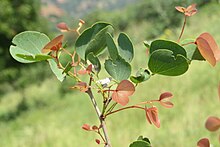Hardwickia
| Hardwickia | |
|---|---|

| |
| Leaves of an anjan tree | |
| Scientific classification | |
| Kingdom: | Plantae |
| Clade: | Tracheophytes |
| Clade: | Angiosperms |
| Clade: | Eudicots |
| Clade: | Rosids |
| Order: | Fabales |
| Family: | Fabaceae |
| Subfamily: | Detarioideae |
| Tribe: | Detarieae
|
| Genus: | Hardwickia Roxb. (1811) |
| Species: | H. binata
|
| Binomial name | |
| Hardwickia binata Roxb. (1819)
| |
| Synonyms[1] | |
|
Hardwickia trapeziformis Graham (1831), not validly publ. | |
Hardwickia is a monotypic genus of flowering plant in the subfamily Detarioideae of the legumes. The only species is the anjan, Hardwickia binata, a tree which is native to India and Bangladesh, and which grows to height of 25-30 meters.[2][3] This plant genus was named after Thomas Hardwicke by William Roxburgh.[4]
Description
Hardwickia binata is a moderate-sized to large tree with drooping branches.[5] The bark of the tree is greyish-brown in colour, rough with deep cracks and it darkens with age.[5] The compound leaves have only two leaflets which are joined at the base.[5] The tiny, white/greenish-yellow coloured flowers are inconspicuous and are easily overlooked.[5] The fruits are short, flat pods about 6 cm long with a single seed attached at the end.[5] The timber obtained from the tree is the hardest and heaviest (among timbers from the trees found in India), is durable and termite resistant.[5][6] The leaves are shed in April and the new leaves emerge in early May.[5] The flowering season is during August–September, the fruits appear after the flowering season and continue to remain till May.[5]
Distribution and habitat
It is a characteristic tree of the dry deciduous forests and can grow on shallow, gravelly soils.[5] In India, it is found in the western Himalayas up to an elevation of 1500 m[7][8] and dry open forests of Central and South India.[5][7] In southern India, it is particularly found in Kadapa, Nellore and Ceded districts and in the valleys of Cauvery and Bhavani rivers[9]
Uses
The bark of the tree is used for making ropes.[6]
The timber obtained from Hardwickia binata is used for making agricultural equipment like cart wheels,
The leaves, succulent stems and twigs serve as fodder for livestock.[11] Bark is found to have a good adsorption capacity for mercury and a modification of the bark is found to be useful for removal of most of the mercury from water under certain conditions.[12][13]
Oleo-resin extracted from the heart wood is used in manufacture of varnishes[14]
Resin exuding from the heartwood is used for dressing the sores of elephants.[15]
The balsam, combined with cubebs and sandal, is used for treating sexually transmitted diseases like leucorrhoea, chronic cystitis, gonorrhoea.[13]
The resin (not the oleo-resin) derived from the tree is used as a diuretic[13]
Cultural and religious significance
Ropes made of Hardwickia and coconut were used to capture elephants in ancient times, according to the encyclopedic work Manasollasa or Abhilashitarthachintamani.This encyclopedia has been ascribed to the Western Chalukya King, Someshvara III, who ruled in the twelfth century AD.[16]
Sangam poets have mentioned and described Hardwickia as yaa. According to Sangam Literature the elephants are fond of the bark and sweet smelling oil of Hardwickia.[17] Hardwickia (Anajan in Sanskrit, Aacha in Tamil/Malayalam) is also mentioned in Sundara Kaandam of Valmiki Ramyana/Kamba Ramayana as one of the trees in Asokavanam where Sitadevi was kept in captivity under a Simpsupa (amherstia nobilis)[citation needed] Tree by the demon king Ravana.[citation needed]
Taxonomy
The
References
- ^ Hardwickia binata Roxb. Plants of the World Online. Retrieved 1 September 2023.
- ^ "Hardwickia binata". Germplasm Resources Information Network. Agricultural Research Service, United States Department of Agriculture. Retrieved 12 January 2018.
- ^ "Hardwickia binata - Species Information". The International Centre for Research in Agroforestry (ICRAF). Archived from the original on 2012-09-27.Note: Archive not available until mid-2013.
- ^ Roxburgh, William (1819). Plants of the Coast of Coromandel; selected from drawings and descriptions, presented to the Hon. Court of Directors of the East India Company. Vol. 3. London: W. Bulmer and Co. p. 6.
- ^ ISBN 9780144000708.
- ^ a b c Saxena, N.P. (2010). Objective Botany (14 ed.). Krishna Prakashan Media. p. 419.
- ^ ISBN 9788185182889.
- ISBN 9781465535627.
- ISBN 9788120613447.
- ISBN 9788122415476.
- ISBN 9788185880990.
- .
- ^ ISBN 9780387706375.
- ^ "Forestry :: Minor Forest Products".
- ^ Travancore Plants. 1914.
- ^ http://scholar.googleusercontent.com/scholar?q=cache:U3Xv-_ZGI98J:scholar.google.com/+On+Elephants+in+Manasollasa%E2%80%931.+Characteristics,+Habitat,+Methods+of+Capturing+and+Training&hl=en&as_sdt=0,5 [dead link]
- ^ Asher, R. E.; Subramoniam, Vadasery Iyemperumal (1971). "Proceedings".
- JSTOR 1223605.
 Media related to Hardwickia at Wikimedia Commons
Media related to Hardwickia at Wikimedia Commons
